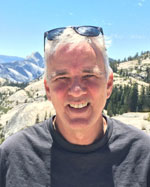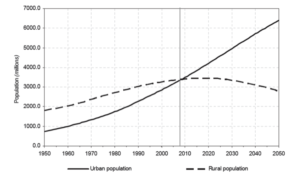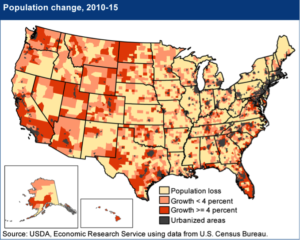The World of the City
 Those of us alive today are witnessing one of the most profound events in all of human history — and it is an event, which is fundamentally geographic in nature. The transformation we are experiencing is the concentration of the majority of the world’s population into urban areas. Although much has been made of the United Nations report that declared as of 2008 half the world’s population live in urban areas, this trend has been a long-term feature of the 20th and 21st centuries. In 1900 only about 10 percent to 15 percent of the world’s population lived in urban areas. The trend towards greater urbanization accelerated from the 1950s and shows no indication of stopping. The United Nations estimates that by 2050 some 70 percent of the world population will live in urban areas. In terms of absolute numbers that means in just 34 years there will be some 6.4 billion city dwellers.
Those of us alive today are witnessing one of the most profound events in all of human history — and it is an event, which is fundamentally geographic in nature. The transformation we are experiencing is the concentration of the majority of the world’s population into urban areas. Although much has been made of the United Nations report that declared as of 2008 half the world’s population live in urban areas, this trend has been a long-term feature of the 20th and 21st centuries. In 1900 only about 10 percent to 15 percent of the world’s population lived in urban areas. The trend towards greater urbanization accelerated from the 1950s and shows no indication of stopping. The United Nations estimates that by 2050 some 70 percent of the world population will live in urban areas. In terms of absolute numbers that means in just 34 years there will be some 6.4 billion city dwellers.

It is not just the proportion of the world’s population living in cities that is increasing. We are also witnessing an agglomerative effect wherein the relative population size of certain cities and their metropolitan areas is increasing at a remarkable pace. This is creating a global constellation of megacities which have populations greater than 10 million. As of 2015 there were at least 35 such megacities. For comparison, in 1985 there were less than 10.
The increase in urban populations is not entirely driven by the birthrates of populations already situated within existing cities. It is also driven by the outmigration of rural populations to urban centers. Thus, according to U.N. estimates, global rural population will decline in actual numbers by about 18 percent, or some 600 million people by 2050. This trend of rural exodus has a long history in Europe and the United States. It is strikingly apparent in U.S. county-level population trends. Despite overall growth in U.S. population, many rural counties, particularly those distant from larger urban centers, are experiencing declines in absolute population numbers.
 The trend of rural exodus is not confined to the developed world. Between 2007 and 2050 rural populations in the world’s less developed regions are expected to decline by 17 percent or some 440 million people. Unlike the 20th century, it is outmigration from the countryside in least developed regions that will drive the global rural exodus numbers going forward.
The trend of rural exodus is not confined to the developed world. Between 2007 and 2050 rural populations in the world’s less developed regions are expected to decline by 17 percent or some 440 million people. Unlike the 20th century, it is outmigration from the countryside in least developed regions that will drive the global rural exodus numbers going forward.
Although the urbanization we are witnessing is a global phenomenon it can hardly be called flat and featureless in terms of finer scale geographic detail. At present the percentage of the population living in urban areas varies greatly by country and world region. According to data from the World Bank, 82 percent of the population in North America live in urban areas. In contrast, the urban percentage in Sub Saharan Africa is 38 percent. In East Asia the percentage of urban dwellers is 57 percent, but this represents a remarkable rise from a base of 22 percent in 1960. Over that same period China has seen its percentage of urban population more than triple, from 16 percent to 56 percent. The distribution and growth of megacities also shows geographic patterning. Tokyo, with approximately 40 million people, is the world’s largest megacity. However, Shanghai and Jakarta are not far behind and growth in the latter may well make Indonesia the home of the world’s largest megacity in the near future. It is notable that eight of the 10 largest megacities are in Asia. In fact, contrasting with the relatively high proportions of urban dwellers in Europe and the United States, only a handful of megacities are found in these regions. These include Moscow, Paris, London, New York and Los Angeles. As a final point, this agglomerative process is likely to intensify in Asia and Africa as overall populations grow and rural exodus accelerates.
The trajectory towards increasing urbanization presents two sets of research challenges to geographers. The first revolves around the fundamental question of how do we classify a specific place, a population or a process as being ‘urban’? Carl Haub, senior demographer at the Population Reference Bureau, has raised this question. He points out that the U.N. focuses upon population sizes typical of larger cities. However, many people living in smaller communities may well follow a relatively urban lifestyle and consider themselves more urbanite than rural. The U.N. itself recognizes this difficulty and has no universal definition, “Because of national differences in the characteristics that distinguish urban from rural areas, the distinction between the urban and the rural population is not yet amenable to a single definition that would be applicable to all countries or, for the most part, even to the countries within a region” (U.N. Department of Economic and Social Affairs). Some of the apparent shift from rural to urban in the U.N. data reflects the growth of smaller communities to a population size that crosses the urban classification threshold in that country. In fact though, not much may have changed for the inhabitants. An alternative would be to classify livelihood as agrarian versus non-agrarian, but this too is nebulous. As geographer Michael Pacione instructs in his text, “Urban Geography: A Global Perspective,” urban can mean many things — population size and density, economic base, administrative structure, etc.
The spatial designation of one locale as urban and one place as rural is also problematic. An interesting remote sensing study published in 2009 by Annemarie Schneider of the Department of Geography at the University of Wisconsin and her co-authors grappled with this. They pointed out that multiple criteria exist to make such a distinction when classifying imagery as urban or rural. Schneider et al favored an approach of developing regional specific criteria for classifying a given locale as urban. From their analysis they concluded that only about 0.5 percent of the earth’s land area could be classified as urban. When one reflects on the large proportion of humans now occupying urban areas this is a remarkable spatial concentration of people. However, things may not be so simple. Geographer Karen Seto, now at the Yale School of Forestry and the Environment, and her colleagues in their paper, “Urban land teleconnections and sustainability,” have also grappled with how one defines urban. They point out that place-based classifications, such as those typical of remote-sensing land-use products, make an artificial dichotomy between the urban and the rural when in fact there is a continuum of land uses and very indistinct spatial boundaries. Using a processes-based perspective that appreciates this continuum and the flows that connect across it is more realistic, and would appreciably expand the land area we might consider urban.
One can imagine that as the nature of economies, telecommunications and the geographies of employment change and become less spatially limited, so too will the geographies of the urban and the urban-rural continuum. In addition, rural economies, demographies and geographies are changing. In the Unites States family farms are replaced by large corporate farms. Mechanization further decreases agricultural workforce needs. At the same time networked urbanites find affordable accommodations or space for start-ups in these increasingly available rural locales. Though agglomeration of these networked or commuting exurbanite populations increase, types of labor shift to non-agrarian and rural regions become increasingly urbanized in function if not in physical form. The hinterlands surrounding the San Francisco Bay Area are an example. At the same time, the inner city cores which experienced depressed real estate markets due to the flight of upper and middle classes and manufacturing are being redeveloped and gentrified in many cities. This in turn is pulling people back to denser urban cores.

Geographers have a major role in studying and determining how the term urban is defined. In this case the focus will need to be both on the spatial and the process-oriented perspectives. Considering the paragraph above we might ask what is the comparative experience in the new Asian megacities in terms of spatial form and processes that link urban populations? Will the patterns of urban evolution experienced in more developed countries also occur in less developed countries? Geographers have been at the lead of considering such questions. Karen Seto’s work is one recent example. We might also consider work in the tradition of the late Neil Smith as represented in his 2002 paper, “New Globalism, New Urbanism: Gentrification as Global Urban Strategy.” In it he not only spoke about the global spread of the gentrification, but also provided a much wider take on globalization, urbanism and the rise of the Asian, South American and African megacities.
The second set of questions in geography’s wheel house concern the socioeconomic, cultural and environmental implications of increasing urbanization and the growth of global megacities. Here geographers have been at the forefront. Work spans from the quantitative study of regional economic geography and the agglomerative process of urban growth to the qualitative analysis of how ethnicity, gender of sexual orientation shape individual experiences and perceptions of urban space and place. Geographers such as Michael Dear, Allen Scott, Edward Soja, Michael Storper and Jennifer Wolch of the Los Angeles School of Urbanism have had global impact through their work on the functioning and increasing economic, social and cultural dominance of the world’s global cities. The rise of Critical GIS, which directly links geography’s growing technical capacity for spatial analysis with social theory and qualitative methods is a newer and particularly exciting development. Geographer Mae-Po Kwan and her students have been recognized leaders in these efforts. Here is an approach that can provide new insights not just on the geographies within cities, but also help come to terms with the spatial and functional complexity of the urban-rural continuum.
Geographers have, to their credit, been aware that we are not just studying regression models and pixels, but the lives and futures of real people. There is the deep vein of social awareness and advocacy that permeates much of the work of urban geographers. David Harvey, who arguably stands as the preeminent urban social theorist of our time, has led the way to a melding of scholarship and social responsibility. For over 40 years, starting with the seminal work “Social Justice in the City” and continuing with a multitude of deeply reasoned works including the 2012 book, “Rebel Cities: From the Right to the City to the Urban Revolution”, Harvey and his students have set the standard for the discipline.
The relationship between urbanization and the environment in the 21st century is also critical and an area where geographers have much to contribute in terms of research and education. This matters both in terms of urban impacts on the physical and biological environment and in terms of the environmental quality for urbanites. As one of many examples of the former, a paper published this week in Nature authored by Sean Maxwell, a Ph.D. student in the School of Geography, Planning and Environmental Management at the University of Queensland in Australia, concluded that urban development was the third greatest extinction threat to species classified as threatened or near-threatened by the International Union for Conservation of Nature and Natural Resources (IUCN) Red List. In fact, the threat to biodiversity by urbanization was found to be almost twice as great as that offered by climate change. From the study of urban heat islands, spatial patterns of air, water and soil pollutants, and health threats to the geographies of parks and outdoor recreational spaces for cities and their neighborhoods, geographers have a strong role to play in the study of urban environmental quality and urban environmental justice. In her 2000 Annals article, “Rethinking Environmental Racism: White Privilege and Urban Development in Southern California,” Laura Pulido, formerly of the University of Southern California and now a Professor of Geography at the University of Oregon, brings together the strands of environment, social justice and racism in a critical assessment of how cities can fail to serve their citizens and the geographies of such injustices. This follows the tradition in urban human geography where scholarship is combined with advocacy.
In closing I reflect upon a figure entitled “The nature of human geography” in Michael Pacione’s text, “Urban Geography: A Global Perspective” in which he has placed Urban Geography at the center of all the other sub-disciplines from Physical Geography to Social Geography to Cultural Geography, etc. This might appear to be hubris, but in the 21st century and for our discipline it is not unreasonable. With most of the world’s population arguably urbanized and this trend to continue, and with cities and megacities having such impacts on global economies, culture, politics, health, the environment, etc., urban geography is indeed of critical importance. We have had a strong tradition in this area and going forward I would hope to see that urban geography can indeed form a center of gravity which brings human and physical geographers to work as teams tackling the research, education and policy challenges that the urbanized 21st century brings. This is also an important nexus where those geography departments which are twinned with planning can build bridges and collaborations that will benefit both parties. There is a long history of urban geographers receiving training in planning or being appointed to planning departments as faculty. Let’s capitalize more on these linkages. It seems to me the AAG Annual Meeting can serve as an ideal venue to bring together human geographers, physical geographers and planners in focused sessions to share work and plot collaborations on urban issues. I wonder how our journals might also serve as catalysts? The 21st century is the world of the city, and geography can capitalize upon great traditions and great potential to help understand and improve this evolving new world. Your ideas on how the AAG can help are welcome!
Join the conversation and share your thoughts on Twitter #PresidentAAG.
— Glen M. MacDonald
